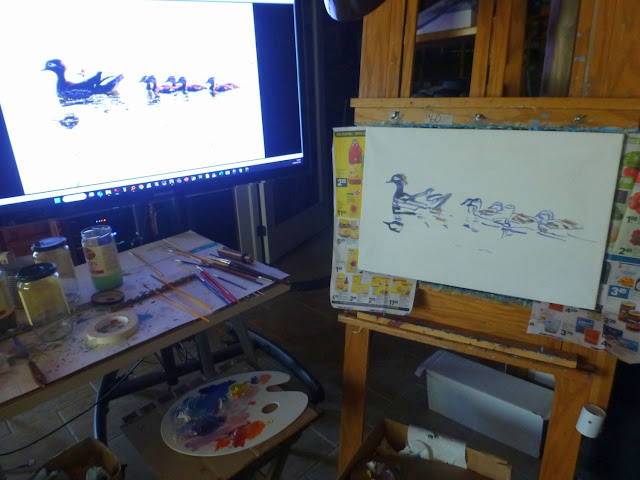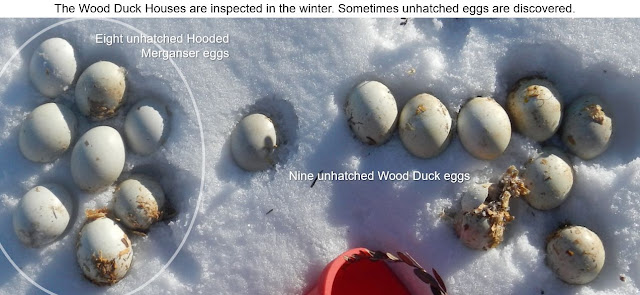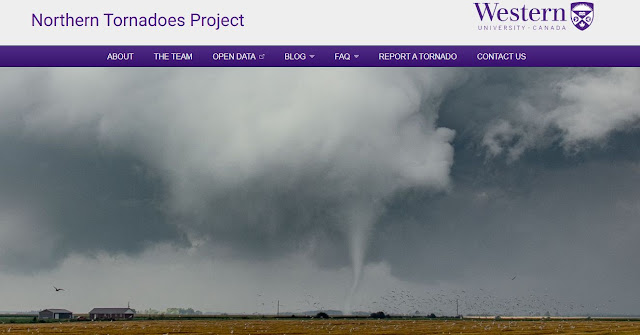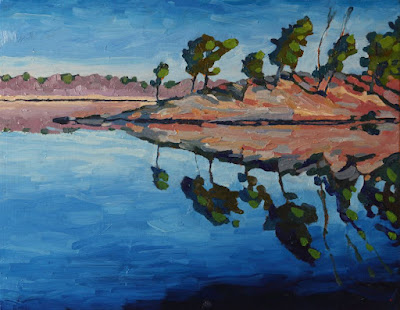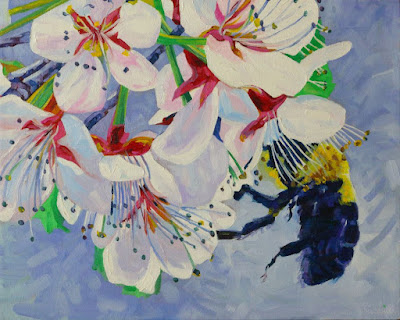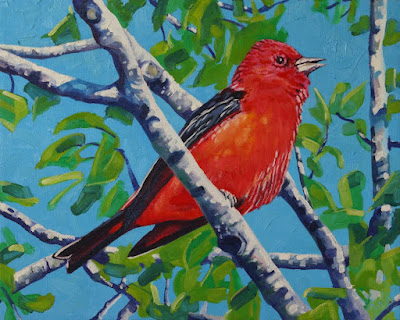 |
#2954 "Scarlet Tanager Song"
16 x 20 by 3/4 depth stretched canvas (inches)
Started 9:00 am Tuesday, June 17th, 2025 |
Heat warnings were encouraging me to seek the air conditioning of the Singleton Studio. As a result, I returned to the ample and generous supply of inspiration provided by my friend John Verburg. Scarlet Tanagers enjoy the Carolinian forest on the property, and this bird was singing to me.
Art is another opportunity to continue to learn. There is still much to learn about nature so that it might be there for future generations. Together, art and learning are science and a wonderful way of life. Not such a great way of making a living, but still satisfying for the soul.
Scarlet Tanagers are spectacular songbirds, and we hear them more often than we see them. Males arrive early in spring to defend loose territories that include mating, nesting, and foraging areas. Territorial singing battles sometimes escalate into confrontations, where one or both males spread and droop their wings and raise their tails in threat. If neither backs down, the standoff culminates in one male chasing another. Scarlet Tanagers are monogamous within each breeding season but switch mates from year to year.
Scarlet Tanagers eat mainly insects along with some fruit and tender buds. The insect diet is wide and varied. While searching for these tidbits, they walk along branches high in the canopy. Scarlet Tanagers perch or hover with fast wingbeats to grab insects from leaves, bark, and flowers, and they catch flying insects like bees, wasps, and hornets from the air. They swallow small larvae whole, but they kill larger prey by pressing it into a branch.
The female chooses the nest site, usually selecting a shaded spot within a cluster of leaves at a juncture of small branches. Nests are typically quite high (50 feet or more from the ground) on a nearly horizontal branch well away from the trunk. The female prefers an unobstructed view of the ground and open flyways from nearby trees. Scarlet Tanagers tend to nest in mature deciduous trees such as maple, beech, and oak, but they also nest in eastern hemlock.
The female gathers nesting material from the forest floor and builds a flimsy nest in 3–4 days, spending relatively little time on it each day. She drops material onto the nest, hops in, and moulds it into shape by pressing her body against the sides and bottom. She then gets out to weave in any loose ends. The nest is a loosely woven saucer of twigs, grasses, plant stalks, bark strips, rootlets, and pine needles. It has a shallow and asymmetrical interior space, lined with grass, fine plant fibres, vine tendrils, and pine needles.
Parents feed their young for up to two weeks after the birds fledge, and then the family disperses before migrating. 
Scarlet Tanagers fly across the Gulf of Mexico between their breeding grounds in eastern North America and their wintering grounds in South America. They usually migrate at night. Scarlet Tanagers winter in mature forests and forest edges, mostly on hills and mountains. They range south as far as the Bolivian lowlands. Scarlet Tanagers join up with other species in foraging flocks.
The following summarizes the four different tanager species.
The good news is that according to the North American Breeding Bird Survey, Scarlet Tanager populations have held steady between 1966 and 2019. Scarlet Tanagers are an interior forest species, so changes in land use have been slower to influence their populations. Nests are in greater danger of being parasitized by Brown-headed Cowbirds in fragmented landscapes. To safeguard the Scarlet Tanager population, researchers recommend preserving and restoring mature forest habitat for breeding, migrating, and wintering birds.
This was a fun painting, and nature continues to inspire.
Warmest regards and keep your paddle in the water,
Phil Chadwick

